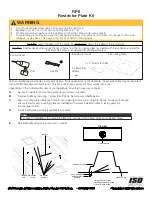
55
4.3 Flue pipe and chimney
The flue pipe is one of the key features for guaranteeing the proper functioning of the stove.
•
The stove is fitted with a Ø80mm round flue outlet and a joint connection to be connected to the flue
pipe.
•
You must be able to clean all the pipes and corners. T-fittings and inspection doors should be used
to make sure all parts of the flue pipe can be reached for cleaning purposes.
•
Use telescopic joint connections to connect the steel rigid flue pipe.
•
Seal the flue pipe joint connection with high temperature silicone sealant (1,000°C). Should the
existing flue opening not be perfectly perpendicular to the firebox flue outlet, use an elbow to connect
them. Inclination must never exceed 45°, with respect to the vertical axis. No constrictions.
•
The chimney must be insulated along its entire length. Thanks to the chimney insulation fume
temperature will remain high optimizing draft, preventing condensation and reducing build-up of
barely ignited particles along the flue pipe walls.
•
The flue pipe in the room can be uninsulated for maximum 200 cm.
•
The chimney must be weather-proof and as linear as possible.
•
The chimney flue must be CE marked according to EN1443.
Flexible metal pipes may not be used.
Examples of flue pipes:
4.4 Draft
Fumes heat up during combustion, increasing their volume. Their density is therefore lower than the one of
the surrounding colder air.
This difference between the inside and outside temperatures of the chimney results in the chimney draft.
The draft must be stronger than the fume circulation resistance so that all exhaust fumes generated during
combustion inside the stove are drawn upwards through the outlet and the flue pipe. Many weather
conditions affect the vent pipe functioning, such as rain, fog, snow, and wind being the most important as it
can create negative pressure.
Read more at adurofire.com
Insulation material
Ø80 cm
”T” fittings
Inspection doors
Max Ø150 mm
Inspection doors
Содержание P1 series
Страница 23: ...23 ...
















































